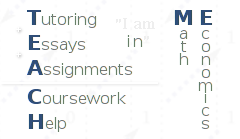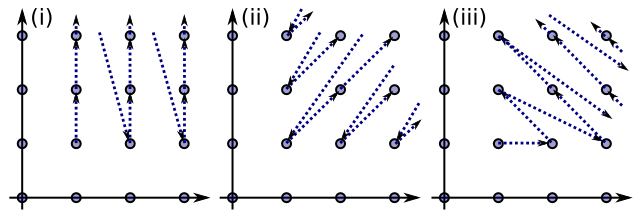Section 3: Problem 12 Solution
Working problems is a crucial part of learning mathematics. No one can learn topology merely by poring over the definitions, theorems, and examples that are worked out in the text. One must work part of it out for oneself. To provide that opportunity is the purpose of the exercises.
James R. Munkres
Let
denote the set of positive integers. Consider the following order relations on
:
(i) The dictionary order.
(ii)
if either
or
and
.
(iii)
if either
, or
and
.
In these order relations, which elements have immediate predecessors? Does the set have a smallest element? Show that all three order types are different.
The following Figure 1↓ illustrates the orders.
Immediate predecessors. (i) In the dictionary order every element
,
, has an immediate predecessor
, while
does not (if
then
, and
).
(ii) Suppose
. Consider two cases. If
and
, then
(either
and
, or
), hence, the immediate predecessor of
in this case is
. If, on the other hand,
or
, then
(if
then
and
, one of which is not possible), and, hence,
, i.e. if
or
, there is no immediate predecessor.
(iii) Suppose
. Consider two cases. If
, then
(either
and
, or
). If
, then
(if
then
), hence,
and
. Therefore, every element except
has an immediate predecessor, namely, if
, it is
, and if
, it is
.
The smallest element. If there is a smallest element, then it must be the least among those without an immediate predecessor (but not vice versa, of course).
In (i) it is
and, indeed, it is the smallest.
In (ii) there is no smallest element without predecessor, as for every
, we have
, but for every
, we have
(another way to see that there is no smallest element in (ii):
).
In (iii) there is only one element without immediate predecessor, which is
, and, as it is easy to see, it is the smallest element.
The order type. Given the answers for the previous questions, it is immediate that the order types are different. Indeed, if there is a bijective correspondence between two orders that preserves the order, then, as it is easy to see, it must also preserve immediate predecessors and smallest elements. However, from this point of view, the structure of each order is different.
| Order | The number of elements without the immediate predecessor | Whether the order has the smallest element |
| (i) | Countable | + |
| (ii) | Countable | - |
| (iii) | 1 | + |
In fact, the order type of the order (ii) is that of the dictionary order on
. And the order type of the order (iii) is that of
.
Indeed, imagine, first, the dictionary order on
, which is the order in (i) extended to the left for all
’s. Now, take this dictionary order, and place it into the positive corner as in (ii). I.e. a point
goes to the point
if
, or
if
. We kind of bended the line
of the dictionary order to fit it into the corner. Now, for each point
of the original order, we take all points above it and place them to the diagonal that starts from the point where the point
was placed. For example,
becomes
,
becomes
,
becomes
etc. I hope you can see how the dictionary order on
becomes the order in (ii) (see Figure 1↑).
If not, then here is a formal bijective correspondence:
. Let denote it as
. Note that
for all
, so that in the dictionary order
iff
, or
and
iff
or
and
, i.e.
, iff in the order (ii)
.
Now, consider
. Place
to
,
to
and
to
, then
,
and
to
,
and
, correspondingly, and continue this way to get exactly the order (iii) illustrated in Figure 1↑. A more formal bijective correspondence between the two is also, of course, possible.

